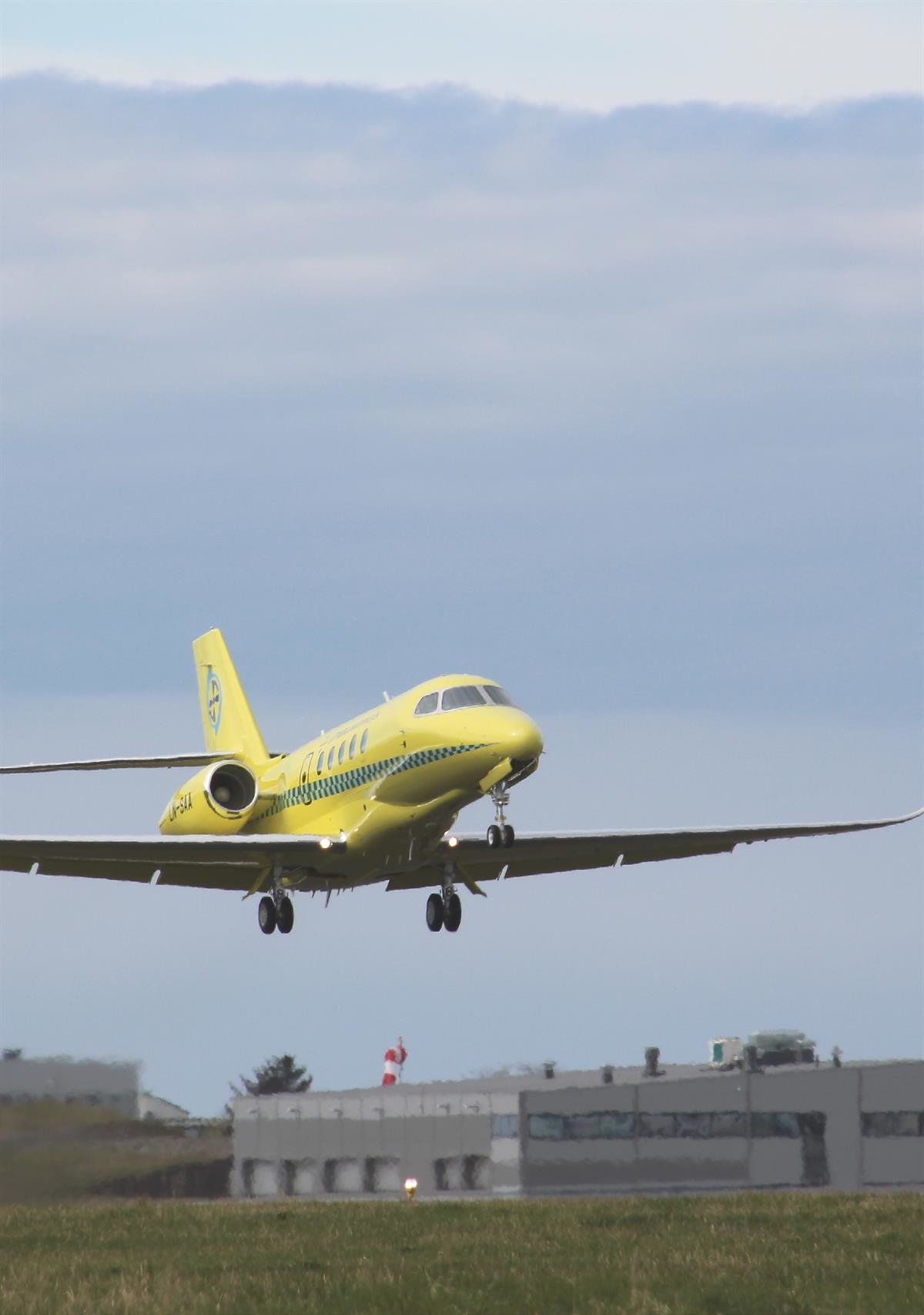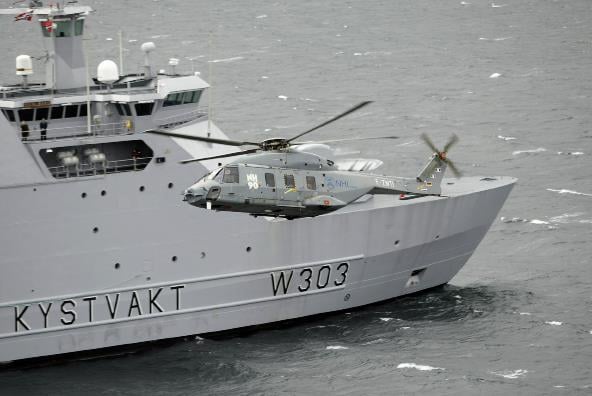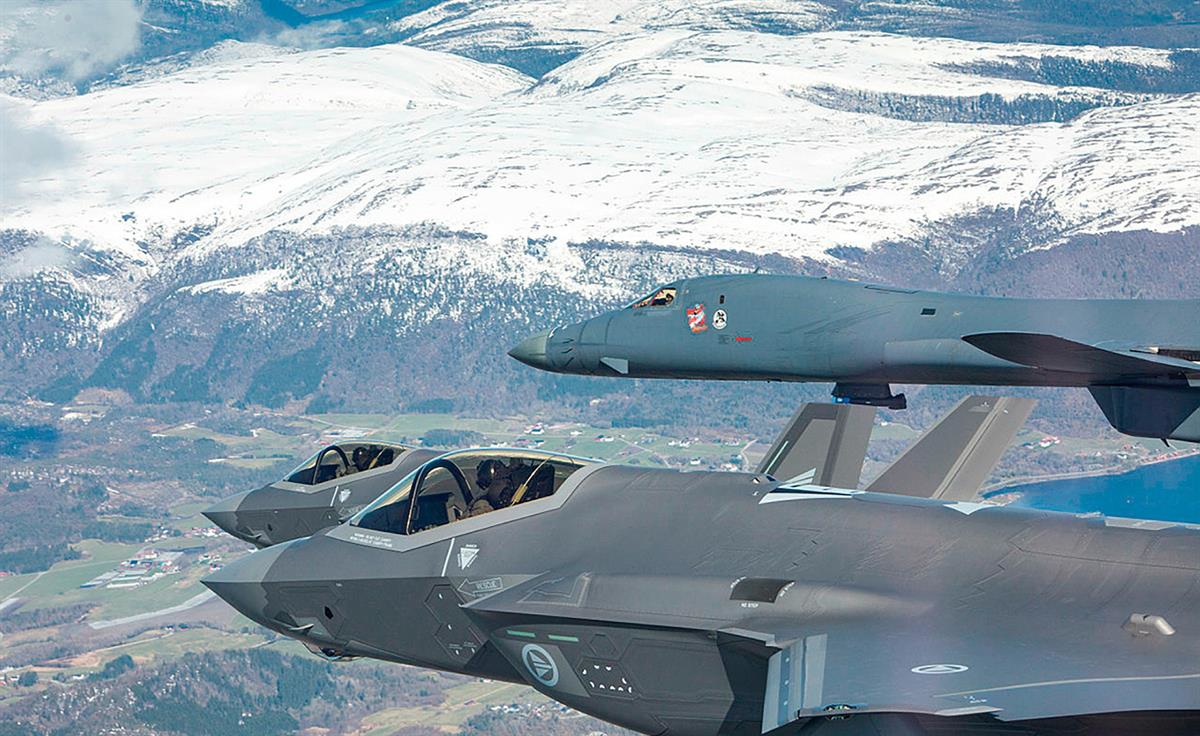6 Organisation of the airspace and prioritisation of access to airspace

Photo: Norwegian Air Ambulance Service Health Trust
6.1 Organisation and classification of the airspace
The annexes to the Chicago Convention contain international standards and recommendations for aviation.12 Annex 11 describes how states’ airspace shall be organised and what services shall be provided in accordance with the airspace’s classification in order to achieve a safe, orderly and efficient flow of air traffic.
Annex 11 provides the opportunity to classify airspace in seven different airspace classes, which are defined alphabetically from A to G. Furthermore, the Annex describes what shall apply in each of these classes in terms of what types of operations can be permitted, who are to be separated from each other, what services shall or can be provided, what speed limitations apply, whether radio communication equipment is required and whether aircraft are subject to clearance from the air traffic services. As part of the SES legislation, the EU has further harmonised member states’ implementation of Annex 11. This also applies to Norway via the EEA Agreement.
Airspaces can be divided into two main categories – controlled or uncontrolled. In controlled airspaces, air traffic services are provided and aircraft in such airspaces are subject to clearances in order to gain access. Controlled airspace can belong to classes A to D. Uncontrolled airspace can belong to classes F and G, whereas airspace class E is a hybrid solution where certain operations are subject to clearance and separated from each other, while other operators can move freely without such instructions. The airspace classes in the beginning of the alphabet have stricter rules and requirements than the latter classes.
In the Norwegian airspace, we use airspace classes A, C and D for controlled airspace, whereas our uncontrolled airspace is classified as G airspace. Controlled airspace is only established where it is necessary in order to ensure the safety of aircraft near airports, along approach and departure routes, as well as during the en route phase between various airports. The rest of the airspace is uncontrolled in order to facilitate use without unnecessary restrictions. The exception from this principle is the many “STOLports”, where the airspace is uncontrolled, but in order to enhance the safety level, there are requirements for two-way radio communication with the air traffic services to be able to operate.
Generally, we can say that it is safer to travel in controlled airspace because most operations therein are ensured separation from each other. In uncontrolled airspace, individual aircraft commanders must personally ensure necessary separation, based on available information and there are no established minimum distances.
Regardless of which airspace class an airspace is defined as, Annex 11 also provides the opportunity to establish areas where flights can only take place on special conditions, restricted areas, and areas where activities are announced that pose a danger to aircraft during flights, known as danger areas. As a main rule, restricted areas are used to protect an activity within an area, while a danger area is used to protect aircraft outside of an area. Both types of areas can be established temporarily or permanently, depending on the duration of the measure. Examples of such areas in Norway are the restricted area over downtown Oslo intended to protect key state functions and danger areas that established around the Norwegian Armed Forces’ firing ranges.
6.2 Priority needs
The airspace and associated services have to be organised, and access has to be prioritised appropriately for all affected service providers and airspace users. This has to be done for all parts of the conflict scale from peace, through crisis and incident management to armed conflict.
The airspace is a limited resource. As a main rule, the regulations facilitate so that multiple airspace users can use the airspace at the same time, while in certain cases it is necessary to reserve airspace for a specific purpose at the expense of other users’ wishes.
To a considerable extent, such conflicting wishes can be adapted with the flexibility of users or with the aid of technological solutions – but not always. As a tool to be able to clarify situations where there are conflicting requests relating to use of the airspace, there is a need for a priority overview of which users are to be given priority in which situations. Such an overview is prepared on the basis of a cooperation between the Civil Aviation Authority of Norway and the Norwegian Armed Forces. The overview is not intended to be exhaustive but will be an important guiding factor for the aviation authorities regarding how the airspace is to be used and for the air traffic services’ daily administration and enforcement.
The overview will apply under normal societal conditions, i.e., not during war or similar states of emergency. In the transition between normalcy and crises, there is currently a lack of prioritisation rules and this should therefore be assessed in more detail.
6.3 Prioritisation criteria
Airspace access is decisive in order for an aircraft to be used for a desired purpose. When there is a need to prioritise between various actors, it is the purpose of the activity that should be given most weight. It is not a decisive factor for the prioritisation whether the aircraft is manned or unmanned during the operations.
Traditionally, the situation is that actors in principle have the same priority, meaning that the first to request airspace access, shall have the highest priority. (First come, first served.) In addition, there are a number of internationally determined rules regarding the duty to yield if multiple airspace users are operating in the same area/airspace.
Aviation shall support society’s goals regarding welfare, safety and economic development. An established overview of how airspace users are prioritised will contribute to providing all actors in Norwegian aviation with predictability in planning, operation and development relating to airspace use and air navigation services, and to an efficient, economical, safe, accessible and robust aviation sector in Norway.

Photo: Norwegian Armed Forces
6.4 Prioritisation of airspace access
National security and facilitation for emergency services are considered to have the highest priority. The possibility of having an efficient and broad use of the airspace in crises and emergency situations must always take precedence over other considerations.
As part of a national security policy, it is a political ambition that Norway shall be attractive for the implementation of NATO exercises and exercises with allies. Therefore, it is important that the prerequisites for conducting large international exercises in Norway and in Norwegian airspace provide good benefits for the units involved in the exercises. International exercises should be given a high enough priority that civil aviation has to expect some inconveniences during the periods in which the exercises are taking place. In order to protect national security, it is important that state flights are well trained for the tasks. This means that it is important to facilitate good training opportunities in everyday life, especially for the emergency services and for the military.
A large part of this training requires either a segregated airspace or the establishment of danger areas.
Civil passenger and cargo transport are very important for Norwegian society. It is crucial that commercial actors can have predictable day-to-day operations, within known and accepted cost limits. Predictability is important, and one should seek to avoid significant inconveniences for scheduled traffic.
Other commercial flights may, depending on the circumstances, have the same priority as, or higher priority than, civil passenger and cargo transport. This will depend on the specific purpose of the flight, and must to a considerable extent be based on whether it involves significant financial values or important societal needs. This may, e.g., involve emergency calls or transport of vital goods, such as medicines or organs.
General aviation shall ensure access to airspace, but must, as a main rule, however, be prioritised lower than the traffic mentioned, below. To the extent one can practically separate general aviation for purposes other than leisure use, this should take priority ahead of leisure use. However, special considerations should be made for larger events and meets for leisure flights and air sports. In the Norwegian Government’s Small Aircraft Strategy, which was presented in August 2017, it is stated that “The Norwegian Government finds that the organisation of Norwegian airspace shall balance the needs of the various users of the airspace. Hobby and leisure flights using small aircraft shall be ensured access to airspace but must nevertheless be prioritised lower than other commercial traffic. ... When establishing controlled airspace, the airspace shall not be of a greater scope than necessary. With the introduction of restricted areas, the authorities shall to the extent possible take into consideration small aircraft activities.”
In principle, drone flights have a lower priority than other traffic. This especially relates to the fact that the cost of adapting drone flights is normally lower than with the use of conventional aircraft. However, here, too, the purpose of the flight is decisive.
The below list summarises the order of priority described above. The priority list shall not be understood as absolute in all circumstances but shall be a clear starting point for the prioritisations the aviation authority and air traffic services shall make when taking regulatory, strategic and tactical decisions regarding the use of the airspace.
- Air ambulance flights.
- Military operations (manned and remotely operated) in connection with the assertion of Norwegian sovereignty, exercising of public authority and in connection with crisis management and other armed missions.
- Flights in connection with police and customs assignments, search and rescue, other crisis management and other acute government missions, e.g., in connection with nature inspections.
- Open Skies flights.
- Commercial aviation and military training flights are given approximately the same priority.
- The following adaptations apply in relation to commercial aviation and military training flights:
- Needs for airspace must not hinder traffic in/out of airports located under this airspace.
- Commercial civil scheduled traffic takes priority on the routes between the biggest Norwegian cities, between Southern and Northern Norway, helicopter traffic offshore and traffic to and from Svalbard.
- Larger military exercises where Norwegian forces are participating shall be given particular weight.
- Preparedness exercises are given considerable weight, although less than military exercises where Norwegian forces are participating.
- Military training flights are given priority in predetermined areas, as long as these are booked in accordance with the Flexible Use of Airspace (FUA) Concept.
- Priority between commercial flights is determined as follows:
- Scheduled traffic is given priority above non-scheduled traffic.
- Passenger traffic takes priority above pure cargo transport.
- The financial value of the flight shall be emphasised.
- Aviation Flight school.
- Drone flights for commercial use.
- General aviation for recreation use, including air sports.
- Drone flights for recreation use.

Photo: Norwegian Armed Forces
6.5 Needs for prioritisation and use of Norwegian and allied military forces in times of peace, crisis and war
Military operations will have a vital role in the organisation of the airspace in times of peace, crisis and incident management and in armed conflict. The military airspace control and authority can take over from the civil authority at a specific preparedness level. This follows from the Act of 15 December 1950 Relating to special measures in time of war, threat of war and similar circumstances (Preparedness Act) and is operationalised through the preparedness system in the Norwegian Armed Forces.
It is of crucial importance for the capability to maintain control of the airspace that the transition between the two phases is regulated in such a manner that the civil-military cooperation, in terms of roles, responsibilities and authority, is clarified and feasible in accordance with national and allied plans, including the Preparedness System for the Norwegian Armed Forces (BFF) and the Civil Emergency Preparedness System (SBS).
The previously mentioned need for military-regulated air navigation services, in addition to the civil services, will facilitate the safeguarding of civil and military aviation in the best and most efficient manner throughout the conflict scale, cf. Chapter 5. This can be solved with the establishment of a military air navigation capacity, integrated into Avinor’s existing services, where military requirements apply. This capacity will then be subject to the operational command of the Chief of NAOC and will be given training and certification regarding military plans and systems, in addition to civil certifications. This scheme can be solved through an expanded preparedness agreement. It is important to practice relevant scenarios in peacetime so that the overall civil-military organisation is capable of planning, leading and implementing operations in accordance with the intention and within specific time frames.
It is especially in two circumstances that the Norwegian Armed Forces has a need for close coordination with and support from civil aviation actors, in this context airport operators and air navigations services, including air traffic services;
- in the execution of armed missions in peacetime, crisis and in case of high alert, including securing of airspace priority and access to civil infrastructure;
- in case of mobilisation and war.
In order to safeguard these needs, the Norwegian Armed Forces is dependent on civil aviation actors having sufficient competence and capabilities with respect to military air operations.
The Norwegian Armed Forces also has to solve operational missions without preparedness legislation having taken effect. Previously, this was in part safeguarded through a cooperation agreement (hereinafter the Preparedness Agreement) between the Norwegian Civil Aviation Administration and the Norwegian Air Force. This agreement was terminated in 2009 and has not been replaced. Requirements for the safeguarding of the Norwegian Armed Forces’ needs for air navigations services were then addressed in the Ministry of Transport’s designation decision to Avinor.
In order to ensure that the Norwegian Armed Forces is able to safeguard its duties described in the Long-Term Plan for the Norwegian Armed Forces, including with a view of competitive tendering of air navigation services, it is desirable to have a basis in acts or regulations that regulates the support from civil aviation actors in peacetime. In 2018, a provision was included in the Regulations of 11 November 2003 Relating to the establishment, organisation and operation of air traffic services, which states that the relevant provider of air traffic services shall safeguard military aviation’s special needs, and that these needs shall be reflected in agreements with the Norwegian Armed Forces. However, this provision does not cover air navigation services as whole, nor does it cover airport operators. Therefore, there may be a need to prepare a regulatory provision that has a broader scope than just for the air traffic services, and which also applies in times of crisis and war. At the same time, it can be considered whether regulatory provisions should be created that set special certification requirements for military air navigation services, with a legal basis in Chapter 17 of the Aviation Act.
The military need for air navigation services will be the same for the entire conflict scale, including peace, crisis and war, but threats and the need for separation will escalate and correspond to the level of conflict. The need for a greater airspace volume will also escalate in step with conflict and military level of activity. Protection against terrorism is also part of the threat assessment that military planners must take into consideration. The Ministry of Justice and Public Security has the overall responsibility for Defence Against Terrorism (DAT) and the civil and military needs that have to be harmonised and coordinated. Anti-terrorism operations are in the same manner as search and rescue operations (SAR) supported by the Norwegian Armed Forces.
6.6 Strategy
The Norwegian Government will:
- Under normal circumstances prioritise airspace users according to the purpose of the flight and review the prioritisations in the transition from normal circumstances to crises.